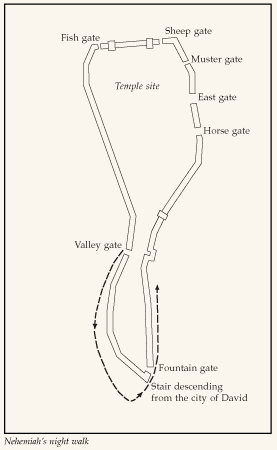Who was Nehemiah in the Bible? | GotQuestions.org
WHO WAS NEHEMIAH IN THE BIBLE?
Ezra and Nehemiah were contemporaries, and they both wrote about the rebuilding of Jerusalem, which occurred approximately seventy years after it was destroyed by the Babylonians under Nebuchadnezzar. Ezra wrote about the rebuilding of the temple under Zerubbabel, while Nehemiah wrote concerning the rebuilding of Jerusalem’s walls. From ancient times, the cities located in the Middle East were surrounded by stone walls with gates that were guarded for the protection of the citizens. The important men of each city would gather at the gate where they would conduct the business of the city, share important information, or just pass the time.
Nehemiah’s account begins in 446 BC. The next year, the prophet Daniel’s “70 weeks of years” prophecy (
Daniel 9:24-27) begins to see its fulfillment. Daniel’s prophecy was based on a specific event, which happened on March 15, 445 BC—the date the prophetic timeline began that will end with the second coming of Jesus Christ. This prophecy speaks of the Messiah’s being “cut off.” It gives details about the Antichrist, how he will come onto the world scene, and how he will move against Israel in his final assault on God and His people. We are currently living in a gap between the 69th and 70th weeks of Daniel’s prophecy.
The portion of Daniel’s prophecy that relates to Nehemiah is found in
Daniel 9:25: “Know and understand this: From the issuing of the decree to restore and rebuild Jerusalem until the Anointed One, the ruler, comes, there will be seven ’sevens,’ and sixty-two ’sevens.’ It will be rebuilt with streets and a trench, but in times of trouble.” Nehemiah was part of the fulfillment of this prophecy, and he listed specific dates, under the inspiration of the Holy Spirit, to provide a written record as to the issuing of the decree to rebuild Jerusalem.
Before he asked the king’s permission to rebuild Jerusalem’s walls, Nehemiah prayed, and God granted his request. As he was leaving Babylon, he met some Arab men who mocked him for what he was about to do.
Nehemiah 2:20 records his statement, which stands even today as a testament to who has the right to the city known as Jerusalem: “I answered them by saying, ‘The God of heaven will give us success. We his servants will start rebuilding, but as for you, you have no share in Jerusalem or any claim or historic right to it.’"
Nehemiah continued in his quest to rebuild Jerusalem. God provided all the necessary workers, and the building began. However, they were not without enemies—those who desired to stop the rebuilding. But God intervened as He had done with Moses (
Exodus 14:14).
Nehemiah 4:20 records, "Wherever you hear the sound of the trumpet, join us there. Our God will fight for us!" This was God’s pre-ordained plan to bring His people out of bondage and back into their land to worship in the temple once again.
We can learn from the life of Nehemiah valuable lessons in restoring and maintaining a relationship with God. As the people returned to the rebuilt city, the first order of business was to make certain that they understood the Law of Moses. So Ezra, a priest, spent many hours reading the Law before the assembly, making sure they understood what God desired.
Nehemiah 8:18 records what should be part of every believer’s life, the daily reading of God’s Word: “Day after day, from the first day to the last, Ezra read from the Book of the Law of God. They celebrated the feast for seven days, and on the eighth day, in accordance with the regulation, there was an assembly.”
Nehemiah stands as a testament to faithfulness and perseverance. He lived far away from his home, yet he never gave up hope that someday he would return to it. He spent most of his life in exile in a pagan land, yet he never wavered in his faith and trust in the God of Abraham, Isaac, and Jacob. He was a prayer warrior, putting everything before the Lord in prayer, interceding on behalf of his people, and he was rewarded for his diligence and perseverance. Nehemiah cared so much for his people that he never gave up the hope of their restoration, not only to their homeland, but to the God that first called their forefather, Abraham, out of the same area and made a covenant with him, one that Nehemiah believed would stand forever.








